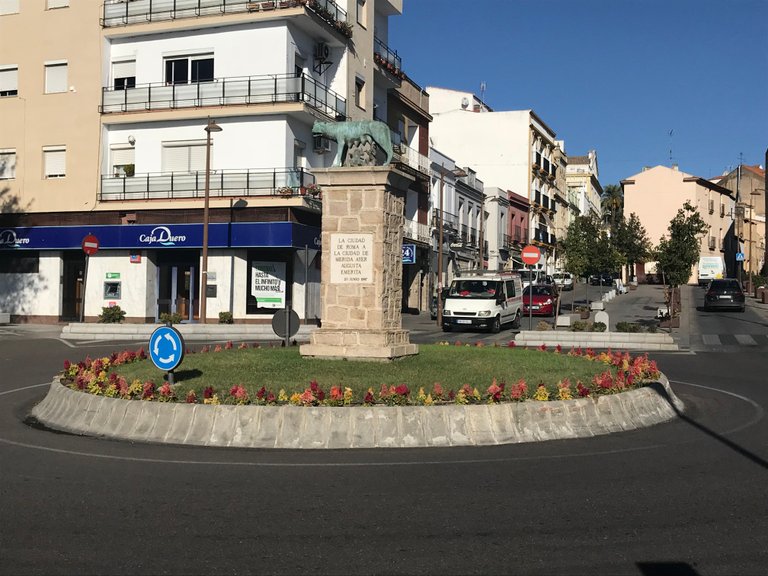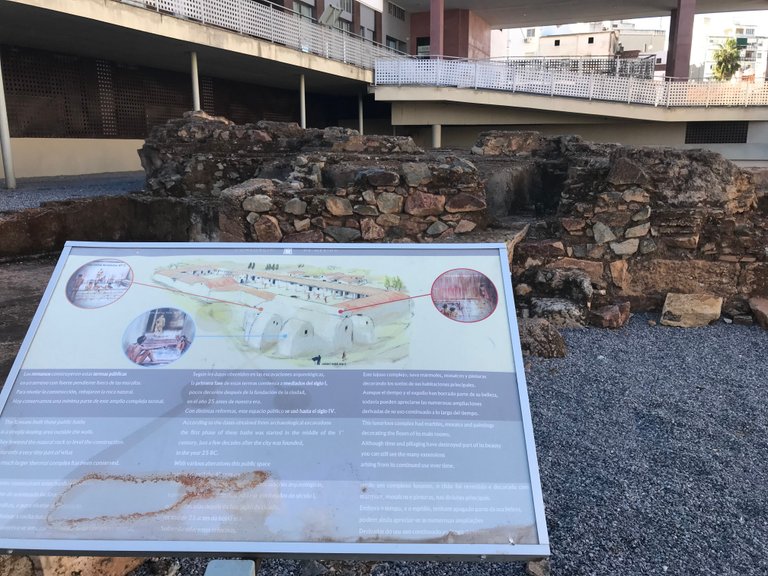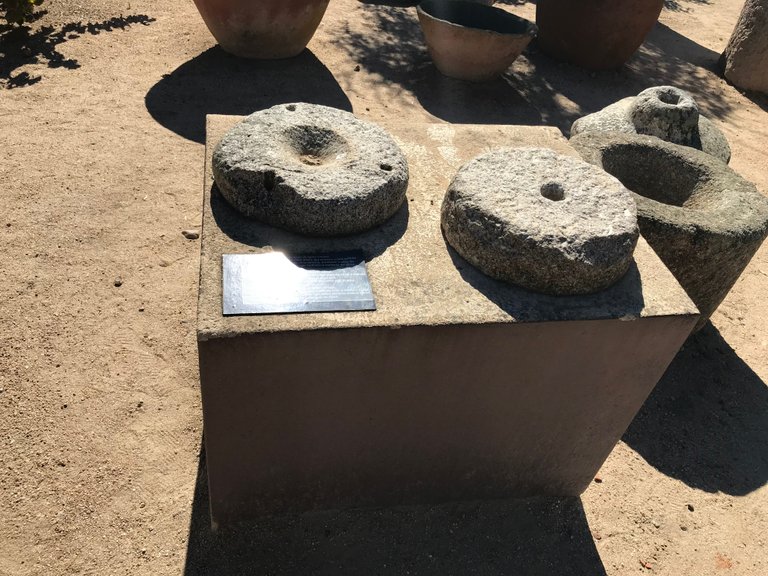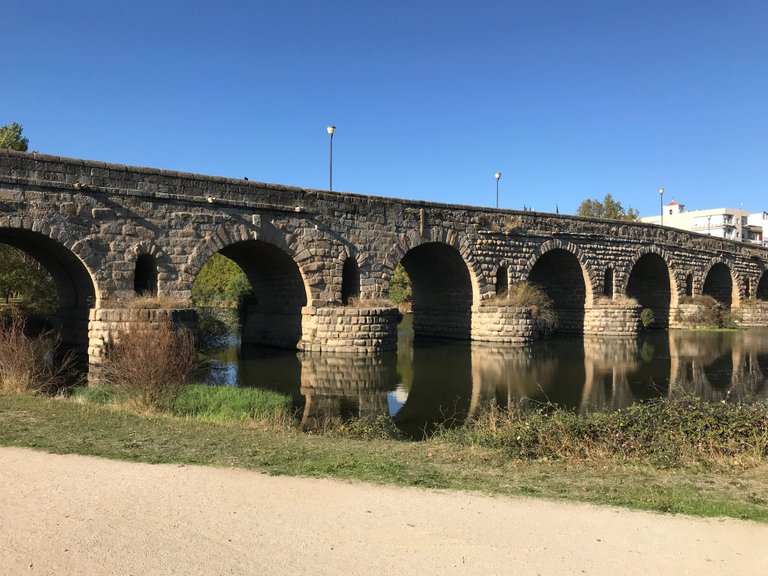
Emerita Augusta
Emerita Augusta, present day Mérida, was founded in 25 BC by Augustus, the first Roman emperor, as a retirement place for veterans or emeriti soldiers. It was a capital of the Roman province of Lusitania which comprised a large part of present day Portugal, including Lisbon. It became a UNESCO world heritage site in 1993.

Eventually, Emerita turned into Mérida, although one can still see the old name in some places such as a football field. Mérida is the capital of the autonomous community of Extremadura in western central Spain.

We took a train from Madrid to Badajoz and arrived at Mérida at 9 in the evening after a four and half long train ride. The landscape between Madrid and Mérida mostly consisted of olive trees and grape vines. It was surprisingly warm when we arrived. The walk from the train station to the apartment, which we found via airbnb, took 30 minutes, and on our way there I calculated that the population of Mérida was around 50,000 based on the size of the buildings which were mostly two or three stories high. It is actually around 60,000.

The Roman Theater
It was in Mérida that I began to fully appreciate the extent to which the Roman empire affected the world with its culture, language and architechture. The Roman name "Hispania" for the Iberian peninsula later became España or Spain. Roman armies invaded the Iberian peninsula in 218 BC. In 19 BC, the conquest of the entire Hispania was completed by Emperor Augustus.
I fell in love with the Roman architecture, especially the Roman Theater which hosts annual summer festivals of Classical Theater. I wish I could attend one of those performances.
The entrance fee to the site of the Classical Theater is 12 euros but for 15 euros one also gets access to other sites.

The theater was constructed shortly after the founding of the city, between 16 and 15 BC. The sculpture in the middle was of the wife of Emperor Augustus represented as goddess Ceres, a goddess of fertility and agriculture.

To the left and the right of Ceres are different representations of Augustus as well as other sculptures. I wonder if ancient Romans looked like the Roman ideal in sculptures. If yes, what a nice sight it must have been:).

Behind the theater is a nice garden with more statues including, of course, that of Augustus, who almost reached the status of a god after his death.



Here is my imitation of a pose of the sculpture of an actress, highlighting my beautiful tan:).

The Amphitheater
Next to the theater stands the Amphitheater where the Romans enjoyed gladiatorial fights and combats between men and exotic beasts. It had a capacity for 15,000 spectators.


Just as in the modern stadiums, there were posh seats (although not literally, since they were made of stone) reserved for high status people, like senators.

Much of gear worn in the fights was quite exotic and was not fit for actual fights. There were many different types of outfits and combatants depending on the nature of the fight.

Although my first reaction to gladiatorial games was that of horror and disdain, upon further thinking I could see the value of this type of entertainment such as bringing people together and giving enslaved people an opportunity for freedom if they were lucky or strong enough to win one of the games. It is still something that is hard to understand for a modern person, but in that context and moral climate it may have seemed reasonable.
Adjacent to the Roman Theater and the Amphitheater is a beautiful garden with roses and cyprus trees.


I came across a cute cat in the garden which looked a little scared. Little did I know that I would meet more of its kind, in unimaginable quantities... but this I will share with you a little later.

One can spend a few lovely hours admiring the theater and the amphitheater or taking a break in the shade while listening to a chorus of birds. Of course, I needed to do some shopping at the store adjacent to the site which was quite delightful since it had an assortment of many beautiful yet tiny things. As a traveler, I had to get rid of many things to lighten up my backpack and become more of a minimalist. I came up with a smart compromise (which I was very proud of) by choosing to buy small, light things that would remind me of my favorite places. In this case, I purchased a set of earrings of goddess Bast, an owl pendant which is the symbol for the Roman goddess of wisdom Minerva or Athena in Greek mythology and a few other small things that I just couldn't resist.
The Temple of Diana
Having eaten a nice meal at a nearby cafe, we continued with our exploration. We passed by the National Museum of Modern Art and continued along a narrow street full of beautiful shops until we reached the crossroads with the signs pointing to the Temple of Diana and the public hot springs.


At first, I thought that the Temple of Diana were the ruins below but it turned out to be Portico del Foro.

The Temple of Diana was actually bigger and more impressive. The temple and the area adjacent to it were an important place for socializing, making transactions, trading and other acitivies that defined the social life of the Romans.

Public Hot Springs
We went back to check out the ruins of the public hot springs which were within a five minute walk from the Temple of Diana.

I contemplated on the high quality of life these Roman veterans had in Emerita Augusta, and wondered why we don't treat our veterans in the same way.

We went back to the Temple of Diana and continued along that narrow road till we reached Alcazaba, a ninth century Muslim fortification by the Roman Bridge.

It is now used as the seat of the local government. It felt quiet and peaceful as we entered the building. There were a couple officials and a security counter. Further in, we could see a beautiful courtyard surrounded by columns in the Roman style. In the middle stood an olive tree.
We left the building and decided to go back to the apartment as it became quite hot. Since Mérida is landlocked, it can be quite cold in the early morning while really hot in the afternoon, with temperatures reaching 30 degrees C, even in October, which is becoming a norm here due to global warming. The idea of siestas and relaxation during hot hours started to make sense to me. It was time for our own siesta.
The next day, we explored Alcazaba, the Roman bridge and other sites.
Alcazaba
Alcazaba is a name for a Moorish fortification in Spain and Portugal. This particular alcazaba was built in 835 after a local rebellion in 805. The fort utilized the walls from ruins of a Roman castle as well as a Visigothic fort.

From one of its walls once could get a great view of the Roman Bridge and a more modern bridge behind it.

The Muslims had an ingenuous way of getting water from the nearby river, Guardana, by digging a canal and letting the water accumulate in a well protected by a building that kept the water clean and cool.


Beasts of burden carried the water up a gently sloping path in the building.

The fort had a spatious courtyard with about 10-15 olive trees and the equipment for making olive oil.




The olive trees were a perfect site for a midday contemplation on the history of Spain.

They also stored cannonballs within the fort.

I was amazed by the significance of this alcazaba in many definitive battles that changed the course of history. The fort was seized by Isabel and Fernando, a power couple that unified many kingdoms into a new country with a new language, Spain. Napoleon's troops seized this fort in 1811. During the Spanish civil war the fort was used by both factions. Who would have thought that this fort could play such an important role in the history of Spain.

The Roman Bridge
The Roman bridge, or Puente Romano, leads directly to the castle. Although it was originally built by the Romans, it underwent many reconstructions due to being destroyed in many battles.

One can have a pleasant walk and enjoy the sight the amazing modern bridge, Lusitania, which was designed by Santiago Calatrava, the same architect who designed much of the City of Arts and Sciences in Valencia (see my post, The spaceship has landed in Valencia).

Lusitania
Speaking of Lusitania, we took a walk on this bridge as well, and were really impressed by the design. While all modren bridges I have encountered in my life prioritized cars, this beautiful piece of work was designed with pedestrians' wellbeing in mind. There is a wide elevated path right in the middle of the bridge which is perfect for a leisurely stroll without being disturbed by cars, their sound, smell and speed. It is quite a beauty, especially in the sunset.



One also get a beautiful view of the Roman bridge from Lusitania.

Before I forget, I need to share with you a little saga about a cat forest in Mérida, which freaked me out a little. As @hkjn and I were taking a walk along Guardana river, we encountered a cute kitten not far from the entrance to a park nearby. I thought it was adorable, just like the cat near the Roman Theater above. But what is cute in small quantitites is slightly terrifying in large amounts, even if it is cats. A further walk in the park led us to what I call "a cat forest".

It is hard to see many cats in the picture above because most were well camouflaged in the shade of the trees. If not for @hkjn, I would have immediately left the park but I mustered whatever courage I had to control my instinct to flee and took a brisk walk by about 50-60 cats that were scattered all over the park, resting yet alert. I wouldn't want to take a walk here at night, or at least, I would need a big dog with me.
Miraculous Aqueduct
There are so many beautiful sights in this small yet extremely charming and old city. Of course, I had to see the aqueduct which had a cool name of the Miraculous Aqueduct. One must absolutely see the aqueducts if one has a chance. I expected them to be canals in the ground and was astonished to see tall constructions instead.



Since the aqueduct was slightly sloping, it let the water travel in a continuous flow on top of it, making it an effective and clean way to transport water over large distances. You can also read more on this here. The water was transported from a water reservoir along this aqueduct which was much longer in the Roman times. I am impressed!
We spent lovely four days in Mérida. Our hosts at airbnb, Juan Carlos and Orfi, were very friendly and extremely accommodating. The food at cafes and grocery stores was great and reaonably priced. I could imagine living here for a year, getting to know the local community and contributing to this wonderful city, Emerita Augusta.


If you liked this post, upvote, resteem and follow me! The next post is on my experiences and impressions at SteemFest!

It was nice meeting you at steemfest. Merida looks awesome!
Nice meeting you too! Have fun in Lisbon!
Wow! Nice article!
Looking forward for meeting you again in the next Steemfest, hopefully!;)
Thanks! Yes, that would be wonderful. Meanwhile, I will follow you on Steemit on your adventures:).
Found you my lovely Traveler !
If you come throught Brussels, step by my home. You will always be welcome... :-) Safe travels on the road... Wish you so many wonderful discovery !
Hi @roxane! So lovely to meet you and Oliver! Thank you! Would love to visit Brussels and hope to speak French with you some day (when I finally get to learn French, the most beautiful language in my opinion:)). Maybe our paths will cross soon when you embark on your journey throughout the world! Hugs.
Cool place.
It was great meeting you there at SteemFest, girl!
It was nice meeting you too, Joy! Hope to see you again at the next SteemFest!